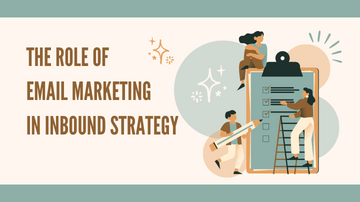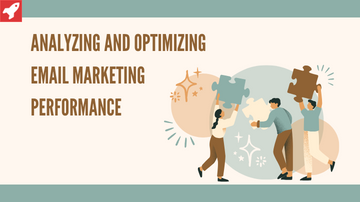Email marketing is a direct communication channel in which messages are sent via email. It is an innovative method that allows businesses to communicate with their target audience, distribute relevant information, and establish long-term connections. Email marketing includes a variety of communication methods targeted at engaging and nurturing prospects, such as newsletters and promotional offers.
The inbound strategy focuses on acquiring, engaging, and satisfying consumers by providing valuable and relevant information. Unlike typical outbound strategy, inbound marketing aims to engage with the audience by giving information that meets their needs and interests. This technique focuses mainly on email advertising and connection.
Join us on this fascinating journey to understand how Email Marketing Can Fuel Your Overall Inbound Strategy and see how it can be effortlessly incorporated into your whole inbound strategy for long-term success in the digital age.
The Role of Email Marketing in Inbound Strategy
Email marketing is an important part of an inbound marketing strategy. It helps with relationship building and nurturing, personalized communication, targeted audience engagement, lead generation, opt-in strategy, compelling content offers, driving traffic to your website, and integrating social media with email campaigns. It helps in:
Building and Nurturing Relationships:
Email sequences can be set up to nurture leads over time, providing valuable content and gradually building trust. Triggered emails based on user behavior or engagement help maintain consistent communication.
Personalized Communication.
Divide your email list into segments based on demographics, behaviors, or preferences to send targeted and relevant content. Use dynamic content and personalized recommendations to tailor emails to the individual recipient.
Targeted Audience Engagement.
Identify specific segments of your audience and tailor content to their interests or needs. Send emails based on user behavior, such as opening previous emails, visiting specific web pages, or abandoning a shopping cart.
Lead Generation.
Use email to drive traffic to dedicated landing pages designed for lead capture. Provide valuable resources or exclusive content in exchange for contact information.
Opt-in Strategies.
Encourage users to subscribe through various touch points on your website. Implement a confirmation step to ensure only interested and engaged users join your email list.
Creating Compelling Content Offers.
Share valuable and relevant content regularly to keep subscribers engaged.
Offer content available only to email subscribers, creating a sense of exclusivity.
Driving Traffic to Your Website.
Use email to inform subscribers about new products, blog posts, or promotions, driving them back to your website. Include compelling calls-to-action (CTAs) that lead recipients to specific landing pages on your site.
Incorporating Links and Calls-to-Action.
Ensure that emails contain clear and enticing CTAs and links for users to take the desired actions. Use visuals and formatting to draw attention to CTAs and links.
Integrating Social Media with Email Campaigns.
Include social media sharing buttons in emails to encourage recipients to share your content. Share your email content on social media platforms to reach a broader audience.
By incorporating these strategies, email marketing becomes integral to an inbound strategy, fostering relationships, providing value, and guiding leads through the customer journey.
Email Marketing as a Distribution Channel
Analyzing and optimizing email marketing performance is essential for ensuring the effectiveness of campaigns and achieving desired results. Utilizing analytics tools, such as those provided by email marketing platforms and Google Analytics, enables tracking metrics like open rates, click-through rates, and conversion rates.
Beta testing is essential for continuous improvement. It allows experimentation with elements like subject lines, content, layout, and calls to action to identify what resonates best with the audience. Integrating email marketing with marketing automation enhances efficiency, enabling the creation of behavioral triggers, automated drip campaigns, and personalized welcome series.
Workflow automation ensures timely and relevant communication, while personalization and segmentation contribute to more targeted content delivery. Incorporating feedback mechanisms, customer feedback tools, and surveys in emails provide valuable insights directly from the audience. Regularly review analytics, conduct beta tests, and refine strategies based on insights practice to optimize email marketing performance and achieve sustained engagement and conversions.
Analyzing and Optimizing Email Marketing Performance
Analyzing and optimizing email marketing performance is helpful for a successful digital marketing strategy. Utilizing analytics tools, marketers can gain valuable insights into key metrics such as open rates, click-through rates, and conversion rates. By closely monitoring these metrics, businesses can assess their email campaigns’ effectiveness and identify areas for improvement. Testing, which involves experimenting with different elements such as subject lines, content, and calls-to-action, provides a method for continuous refinement and enhancement of email content.
Integrating email marketing with marketing automation allows creating personalized and automated workflows based on user behavior, ensuring timely and relevant communication. Workflow automation smoothens processes, such as drip campaigns and welcome series, contributing to a more efficient and targeted approach.
Personalization and segmentation further enhance engagement by delivering content to specific audience segments. Regularly reviewing analytics data, conducting tests, and refining strategies based on insights contribute to an ongoing improvement cycle, ultimately optimizing email marketing performance and driving better results.
Future Trends in Email Marketing and Inbound Strategy
Advancements will significantly influence the future of email marketing and inbound strategy in artificial intelligence (AI) and predictive analytics. AI can enhance personalization by analyzing user behaviors and preferences, enabling marketers to deliver highly crafted content to individual recipients. Predictive analytics can anticipate customer needs, helping businesses proactively shape their email campaigns based on data-driven insights. From predictive lead scoring to AI-powered content recommendations, integrating these technologies can revolutionize how brands engage with their audience, making email marketing more intuitive, efficient, and impactful.
Email marketing continues to provide greater engagement and varied content experiences. Interactive components in emails, such as interactive carousels, polls, and surveys, make the experience more engaging and customized. Dynamic content, powered by user data and behavior, guarantees that emails are personalized in real-time, providing recipients with relevant material to their preferences and behaviors. This trend draws attention and promotes more interaction and click-through rates. As technology advances, including interactive and dynamic components in emails, is expected to become more common in email marketing tactics, resulting in higher user engagement and conversion rates.
Final Words
This examination of email marketing within the framework of an inbound strategy has shown a few essential elements for its execution. From relationship development and nurturing to specific communication, targeted audience engagement, and lead generation, email marketing is developing meaningful connections with your target audience. The conversation also addressed the necessity of opt-in tactics, creating appealing content, and using email to drive visitors to your website. Furthermore, techniques for increasing the effect of email marketing included the use of links, calls-to-action, and social media integration.
As we move forward, adopting future email marketing trends such as artificial intelligence and interactive content becomes necessary for keeping ahead in digital marketing. The potential for AI and predictive analytics to improve customization and the emergence of interactive, dynamic content demonstrate how email marketing is developing. Firms are encouraged to integrate and utilize these insights into their plans. Use analytics tools for continuous improvement, automation for efficiency, and a forward-thinking attitude to adapt to the ever-changing marketing landscape. Businesses may use this to improve their email marketing effectiveness, establish relationships with their target audience, and ultimately achieve long-term success with their inbound strategy.




